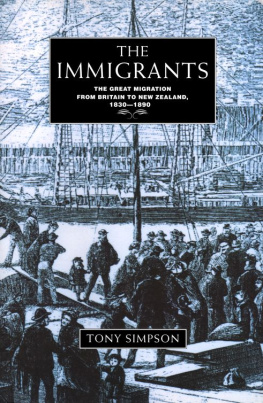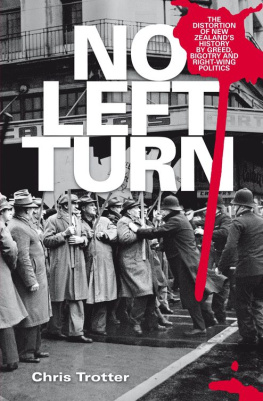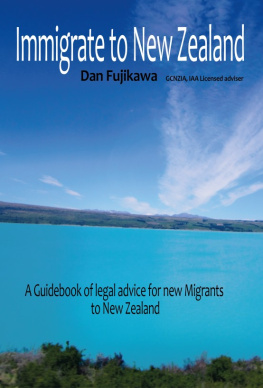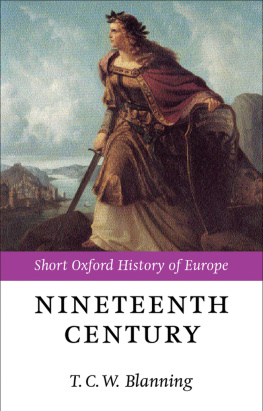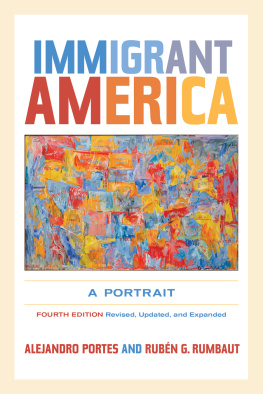CONTENTS
CHAPTER ONE
THE COMING OF THE PAKEHA
CHAPTER TWO
THE STATE OF BRITAIN IN 1830
CHAPTER THREE
EMIGRATION AND NEW ZEALAND
CHAPTER FOUR
THE WAKEFIELD SETTLEMENTS IN NEW ZEALAND
CHAPTER FIVE
POOPDECK AND STEERAGE 18401855
CHAPTER SIX
THE STATE OF BRITAIN 18501870
CHAPTER SEVEN
THE PROVINCES AND IMMIGRATION 18551870
CHAPTER EIGHT
ALTERED DAYS 18551870
CHAPTER NINE
THE DECLINE OF BRITISH AGRICULTURAL EMPLOYMENT 18701855
CHAPTER TEN
VOGEL AND THE IMMIGRANTS 18701885
CHAPTER ELEVEN
THE LAST FAREWELL
CHAPTER TWELVE
EXPERIENCE AND OUTCOMES: A CONCLUSION
Weleftournativeland,andfaraway
Acrossthewaters,soughtaworldunknown;
Butdidnotknowthatweinvainmightstray
Insearchofonesolovelyasourown
Alexander Marjoribanks, 1845
B etween 1853 and 1876, 4,023,518 outward emigrants are recorded as leaving the British Isles, including Ireland. To these must undoubtedly be added many more whose leaving was, for one reason or another, never recorded. Some writers have suggested a figure more than double that supplied by the official statistics. Few of these emigrants returned. This is an astonishing movement of peoples, ranking historically, for example, with the westward population movements which brought down the Roman Empire in the sixth century. Who these people were, why they left their homelands, and where they went are some of the facts fundamental to an understanding of British history in the nineteenth century.
Over the same period, 804,366 of these emigrants came to Australia and New Zealand. This fact is similarly crucial to our understanding of New Zealand history since that time. Until 1864, migrants to New Zealand from Australia far outnumbered those arriving direct from the United Kingdom. This continued to be largely the case until the 1870s, when there was a burst of mass, direct migration. Between 1861 and 1876 the non-Maori population of New Zealand rose from 99,021 to 399,075. Of this increase over the same period, 207,000 was contributed by net immigration. It was not until nearly 1890 that the natural rate of increase of the New Zealand population (the excess of births over deaths) exceeded the population gain from immigration. Of all those who entered New Zealand as immigrants in the century to 1960, more than half had done so before 1890. It is important for us to know, therefore, who these immigrants were, why they came to New Zealand in particular, what perceptions they carried with them, and how they responded to the emigrant experience.
One of the difficulties of doing this is the problem of establishing anything other than the most basic facts about New Zealand immigration. During the nineteenth century, anyone who got off a ship in New Zealand was counted as an immigrant and anyone who left was counted as an emigrant. This is a fairly rough measure, especially given the laxity of many officials during a time when accurate counting was neither so highly regarded nor so readily attained as it is today (when most incomers arrive by air through a very small number of entry points). Nor do the British statistics help much. These not only fail to distinguish between those leaving for Australia and for New Zealand but also cannot tell us how many of those who left went first to Australia and then to New Zealand. The New Zealand arrival statistics suggest, however, that between 1861 and 1891 the net immigration to New Zealand was 272,990.
Raw aggregates of this sort, however dramatic, are necessarily misleading. The pattern varies from year to year. The years 1863 and 1874, for instance, were high points in which the net immigration flows were respectively 35,120 and 38,106. By 1868 and 1881 these flows had fallen to 860 and 6,376 respectively. In 1888 there was actually a negative outflow of 9,175. What we have in these figures are responses to events and circumstances in New Zealand, and in the countries of origin of the immigrants. It is important to know at the very least what these circumstances and events were, what was happening in Britain, and what it was that was drawing people to New Zealand during the nineteenth century.
But as soon as we attempt to go further into such fields as country of origin there is a difficulty. There are some figures available which show that in 1861 about 35% of the New Zealand population was born in England, 28% was New Zealand born, 16% was from Scotland, 9% from Ireland, 8.5% from Wales, 2.6% from Australia, and the balance from a wide range of other countries. Beyond that it is almost impossible to reach any reliable conclusions, because in 1972 the Department of Statistics, which had been patiently collecting, although not collating, raw data on original birthplaces of the population since the beginning of comprehensive censustaking in 1857, in a breathtaking exercise in official vandalism destroyed all of the nineteenth-century returned questionnaires. So we will never know the answers to some crucial questions concerning the origins of immigrants. Other sources such as shipping lists can partially repair this deficiency, but not completely. Thus, all we are able to say with any certainty
Even the breakdown of this large lump into its basic ethnic components is problematical. Most historians simply repeat the conclusions of their predecessors that this was made up of about 60% English and the balance evenly divided between the other groups. But when these conclusions are traced to their origins they transpire, as is too often the case, to be simply the reified beliefs of the earliest historians in this case G. H. Scholefield, who in his entry in the 1933 edition of the CambridgeHistoryoftheBritishEmpire was pleased to report to his readers that the purity of the British race is being well conserved in New Zealand.
Notwithstanding this paucity of hard data, historians who have dealt with the matter have never hesitated to draw broad conclusions about the nature of New Zealand immigration and its consequences. As a result, two broad historiographical schools have developed. These schools share certain basic presuppositions and beliefs. The major of these is that immigration to New Zealand happened in three stages. There was first a period in which significant immigration was under the auspices of the New Zealand Company and its satellites. This period ended about 1855. There was next a period partially characterised by immigration assisted by provincial governments and, for a short time, encouraged by the discovery of gold in some areas. This period ended about 1870. The third and most significant period of immigration covers the decade and a half to 1885, and was characterised by central government assistance as a crucial component in a comprehensive programme of public works and development. This is usually known as the Vogel period, from its political progenitor.
Those emigrants who were driven from their homeland by social circumstances found in New Zealand a much more open society than that they had left, and one which allowed those who wished to do so and were prepared to work the chance to do well and realise their ambitions. But international trade depression curtailed these opportunities from the late 1870s until, in the 1890s, the cloud began to lift and the New Zealand economy was able to recover. During the so-called Long Depression of a decade or more which ended in 1895, two important developments had occurred.

